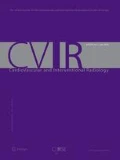Abstract
Introduction
Early literature suggested that the size of the uterus, the size of the dominant fibroid, and the amount of applied embolization particles would be the risk factors for major postprocedural complications, but recent publications have confuted these early results. The purpose of our study was to evaluate whether the size of the dominant fibroid would influence the complication rate and effectiveness in a large single-center cohort.
Patients and Methods
From 28 April 2008 until 31 December 2012, 303 patients had uterine artery embolization (UAE). 262 patients had small [largest diameter <10 cm (Group 1)], 41 patients had large [largest diameter >10 cm (Group 2)] fibroid. UAE was performed from unilateral femoral access using 500–710 and 355–500 µm polyvinyl alcohol particles. Periprocedural and postprocedural complications and numerical analog quality-of-life scores (0—unbearable symptoms; 100—perfect quality of life) were listed and statistically analyzed.
Results
During the mean follow-up time [7.79 ± 5.16 (SD) month], data on 275 patients (275/303 = 90.8 %) were available. Quality-of-life score was 33.3 ± 23.5 and 33.5 ± 24.1 before, whereas 85.6 ± 16.0 and 81.5 ± 23.5 after UAE in Group 1 and Group 2, respectively, (Mann–Whitney U test one-sided, p = 0.365). There were 4 myoma expulsions, 1 acute myomectomy, and 2 acute hysterectomies reported from Group 1, meanwhile 1 myoma expulsion, 1 acute myomectomy, and 2 acute hysterectomies were documented from Group 2 (NS differences).
Conclusion
There was no significant difference in the effectiveness and in the number of minor and major complications between fibroids with <10 cm largest diameter compared to those >10 cm.
Similar content being viewed by others
References
American College of Obstetricans and Gynecologists (2008) ACOG practice bulletin. Alternatives to hysterectomy in the management of leiomyomas. Obstet Gynecol 112(2 Pt 1):387–400
Ravina JH, Herbreteau D, Ciraru-Vigneron N, Bouret JM, Houdart E, Aymard A, Merland JJ (1995) Arterial embolization to treat uterine myomata. Lancet 346(8976):671–672
Goodwin SC, Vedantham S, McLucas B, Forno AE, Perrella R (1997) Preliminary experience with uterine artery embolization for uterine fibroids. J Vasc Interv Radiol 8(4):517–526
Pinto I, Chimeno P, Romo A, Paúl L, Haya J, de la Cal MA, Bajo J (2003) Uterine fibroids: uterine artery embolization versus abdominal hysterectomy for treatment—a prospective, randomized, and controlled clinical trial. Radiology 226(2):425–431
Spies JB, Cooper JM, Worthington-Kirsch R, Lipman JC, Mills BB, Benenati JF (2004) Outcome of uterine embolization and hysterectomy for leiomyomas: results of a multicenter study. Am J Obstet Gynecol 191(1):22–31
Spies JB, Spector A, Roth AR, Baker CM, Mauro L, Murphy-Skynarz K (2002) Complications after uterine artery embolization for leiomyomas. Obstet Gynecol 100(5 Pt 1):873–880
Volkers NA, Hehenkamp WJ, Birnie E et al (2006) Uterine artery embolization in the treatment of symptomatic uterine fibroid tumors (EMMY trial): periprocedural results and complications. J Vasc Interv Radiol 17(3):471–480
Pelage JP, Le Dref O, Soyer P, Kardache M, Dahan H, Abitbol M, Merland JJ, Ravina JH, Reymer R (2000) Fibroid related menorrhagia: treatment with superselective embolization of the uterine arteries and mid-term follow-up. Radiology 215(2):428–431
Worthington-Kirsch RL, Popky GL, Hutchins FL Jr (1998) Uterine arterial embolization for the management of leiomyomas: quality-of-life assessment and clinical response. Radiology 208(3):625–629
Katsumori T, Nakajima K, Mihara T (2003) Is a large fibroid a high-risk factor for uterine artery embolization? Am J Roentgenol 181(5):1309–1314
Firouznia K, Ghanaati H, Sanaati M, Jalali A (2008) Uterine artery embolization in 101 cases of uterine fibroids: do size, location and number of fibroids affect therapeutic success and complications? Cardiovasc Intervent Radiol 31(3):521–526
Parthipun AA, Taylor J, Manyonda I, Belli AM (2010) Does size really matter? Analysis of the effect of large fibroids and uterine volumes on complication rates of uterine artery embolisation. Cardiovasc Intervent Radiol 33(5):955–959
Smeets AJ, Nijenhuis RJ, van Rooij WJ, Weimar EA, Boekkooi PF, Lampmann LE, Vervest HA, Lohle PN (2010) Uterine artery embolization in patients with a large fibroid burden: long-term clinical and MR follow-up. Cardiovasc Intervent Radiol 33(5):943–948
Conflict of interest
Viktor Bérczi, Éva Valcseva, Dóra Kozics, Ildikó Kalina, Pál Kaposi, Péter Sziller, Szabolcs Várbíró, and Erzsébet Mária Botos have no conflict of interest.
Statement of Informed Consent
Informed consent was obtained from all individual participants included in this study.
Statement of Human and Animal Rights
All procedures performed in this study involving human participants were in accordance with the ethical standards of the institutional and/or national research committee and with the 1964 Helsinki declaration and its later amendments or comparable ethical standards.
Author information
Authors and Affiliations
Corresponding author
Rights and permissions
About this article
Cite this article
Bérczi, V., Valcseva, É., Kozics, D. et al. Safety and Effectiveness of UFE in Fibroids Larger than 10 cm. Cardiovasc Intervent Radiol 38, 1152–1156 (2015). https://doi.org/10.1007/s00270-014-1045-4
Received:
Accepted:
Published:
Issue Date:
DOI: https://doi.org/10.1007/s00270-014-1045-4




